617 Search Results for tell me about it
November 14, 2012
by Carole Zangari -
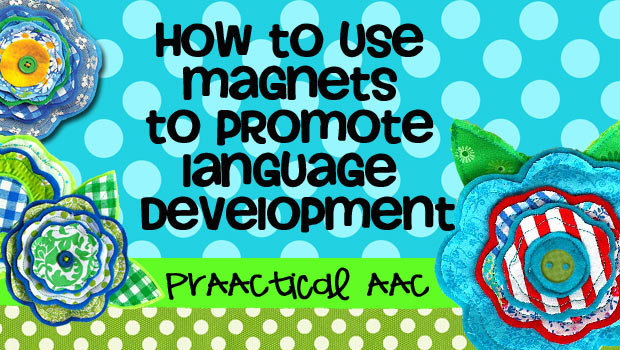
Want to help AAC learners accelerate their receptive vocabularies? Here’s one quick and easy step in the right direction: Talk to them. We’re not trying to be snarky here. The truth is that we speak less to people who are minimally verbal than we do to people who talk. In general, kids with AAC needs hear far less language than speaking children do. Fewer words heard means fewer opportunities to learn language. That’s a cycle worth breaking. When we’re around typically developing children, they’re always asking questions. “What’s in the bag, Mom?” “Why is she doing that?” “How come Billy gets to have one and I don’t?” “Where are we going?” “Are we there yet?” Kids ask lots of questions, particularly in the early years. Annoying? Sometimes. Valuable? Always. From a language learning perspective, those pesky questions serve a very useful purpose: they invite (or demand) a linguistic response. They... [Read More...]
September 2, 2012
by Robin Parker -

We have recently been surprised (ok, shocked) by the absence of communication supports in educational settings that are supposed to be supporting learners with significant communication challenges. To be even more specific and blunt, the students do not have functional spoken speech. They can’t speak to let you know: what they need, what they don’t need or want, how they feel, what they see, what interests them, what questions they have, what they like and don’t like, when they really reallywant something, etc., etc. etc. And, trust us, they do need to say all of these things. If you work with anyone who does not use spoken speech and we mean ANYONE, they deserve the basic right to communicate with you. Our PrAACtical AAC Absolute A’s: AAC displays need to be accessible ALLOVER. There is no special ‘communication time.’ Communication teaching is ALL the time in authentic situations.... [Read More...]
July 22, 2012
by Carole Zangari -
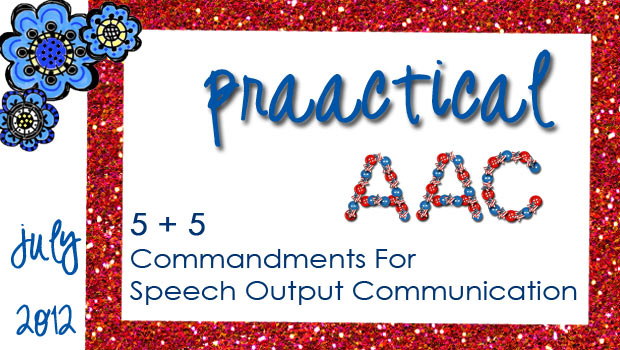
Once in awhile, we come across something that is just too good to keep to ourselves and has to be shared in its entirety. This post is a paraphrase of the Ten Commandments for Voice Output by the Provincial Integration Support Program (PISP) from the Ministry of Education in British Columbia. – You can get the original document here. – Ten Commandments for Voice Output 1. The AAC device is the student’s voice. Messages should be in the first person and reflect the age and gender of the user. 2. The learner needs full access to the device as well as many planned opportunities each day to use it. 3. With training, peers can and should be involved in the programming process. 4. People need to communicate all day long. The device should be available to the communicator at all times. 5. Messages should be meaningful to the... [Read More...]
June 13, 2012
by Carole Zangari -
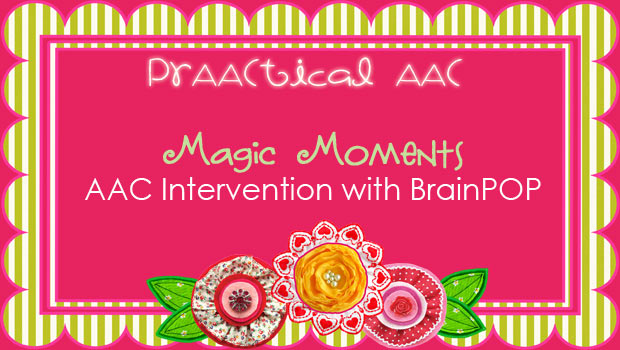
There’s so much to love about BrainPOP. Geared for students in 4th-12th grades. Solid curricular content. Engaging animation and really fun educational games. Aligned with Common Core. Searchable by learning standard, subject, or grade level. Built-in assessment. Evidence-based. Web-based and app versions. Closed captioned videos. English and Spanish editions. Additional resources for educators. A simplified version for younger learners. And lots of it for free! – I’ve just scratched the surface of this wonderful site, which has been around since 1999, and is growing in depth and breadth. It’s perfect for some of the older students with whom we work and has a lot of potential for AAC learning. – Magic Moments: Ideas for AAC Intervention with BrainPOP 1. Navigation: Even some of our older students are still learning to find their way around complex AAC systems. The engaging content in the BrainPop videos create a fun context for activities... [Read More...]
May 24, 2012
by Robin Parker -
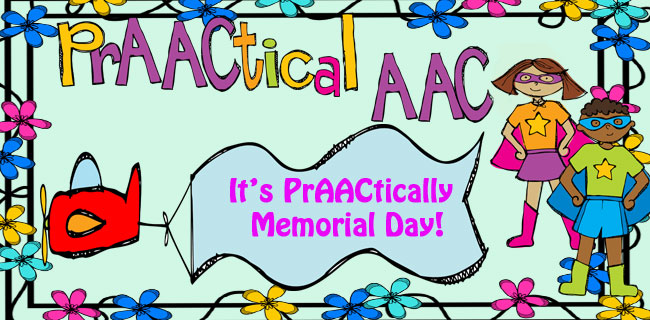
Memorial Day Weekend is big for us. We remember, appreciate, and honor the people who have protected our freedoms. We both have annual relaxing weekends planned. As we started to get ready, though, we started looking for Memorial Day AAC materials. It was surprising to see that there was not much to be found. We found some gluten-casein free Memorial Day recipes, which are great, but what about symbols to go with the recipes or symbols to explain the holiday and what about AAC language activities for the typical long weekend or trip? Not much…. So as we began preparing for our own weekends, these are some of the things we have done or are doing for PrAACtical AAC at home and on our mini-vacations: – Before We Leave Create a personal participation story (modified social story) so ALL the children can SEE the language for the trip. Here’s something that... [Read More...]
May 19, 2012
by Robin Parker -
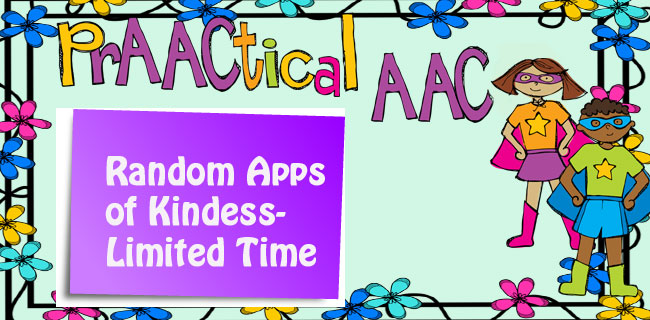
Thanks to Smart Apps for Kids for another great app review AND notification of a great FREE App. We are writing this quickly because it is unclear how long Touch and Write will remain free. After reading the review in Smart Apps for kids, we immediately got the app and tried it out. Although it was developed to help teach fine motor writing skills, here are some additional ways we are going to use it to facilitate communication and language skills. Please let us know if you have some additional ideas. Choice making- the learner can choose the what you write with (ketchup, shaving cream, paint, chocolate pudding and many more), you can also choose the paper type from 28 options, and you can also choose to hear music or not, and whether or not to have tracing cues Turn Taking and Choice Making- This activity can... [Read More...]
April 23, 2012
by Robin Parker -
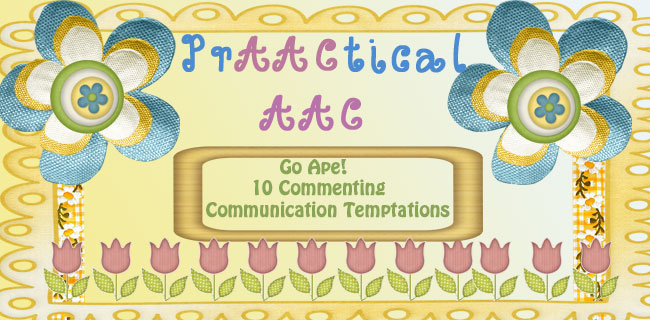
More About Communication Opportunities: It doesn’t matter your personality, but for students who do not naturally comment, you need to go ape! And then still, you need to teach with wait & signal cues, visual supports, aided language input, modeling, expansions, and positive feedback. We will never forget a semester with Mikey and our hair clips of butterflies, whales, dinosaurs, and even a spider. These hair clips allowed for the item to hang in our face…… until Mikey commented and we could ‘go ape’ with surprise. A great strategy to use with commenting communication temptations is Wait & Signal. Wait and Signal involves setting up the temptation and then pausing with raised eyebrows like you expect the learner to take a ‘turn/a conversational turn’. As always, make sure the learner has access to the appropriate communication device or communication boards. 10 additional commenting communication temptations and opportunities: Move a huge stuffed... [Read More...]
April 7, 2012
by Carole Zangari -
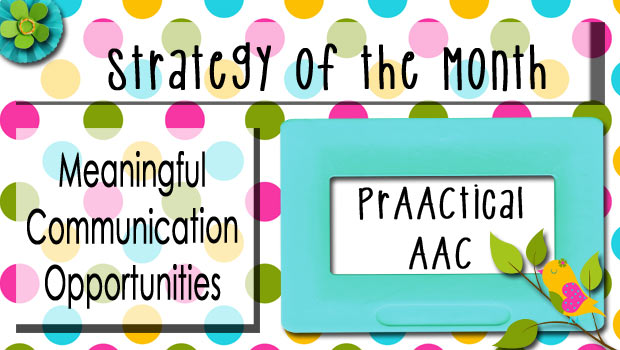
April is springtime where we live and spring is a time of beginnings. It’s fitting, then, that our AAC strategy of the month speaks to the very beginning of AAC intervention. Learning how to create focused opportunities to teach or practice an AAC skill is a pivotal skill for SLPs. The concept is a simple one: create an environment in which the learner WANTS or NEEDS to display the target skill. – Communication opportunities are related to the concept of communicative temptations. As SLP blogger Becca Jarzynski of Child Talk puts it “Communication temptations are pretty much just what they sound like: we set up the environment to tempt children to communicate with us.” Stop by and read her excellent post here . While Becca focuses on their use with young children, the approach can be used with people of any age. – Tempting people to communicate is all about... [Read More...]
March 17, 2012
by Carole Zangari -
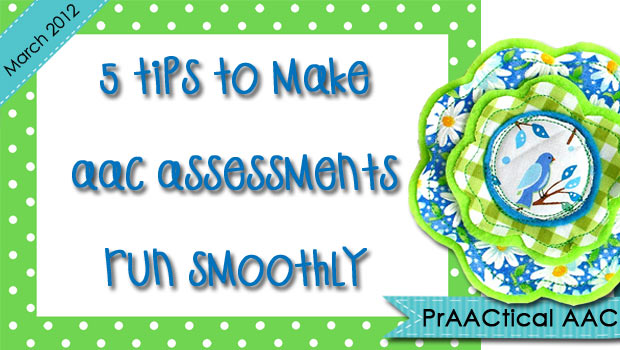
No one likes to be tested, least of all people with communication difficulties who don’t have the tools to express their anxiety or discomfort in the ways they would like to. Some of the people we evaluated had real issues with this and so we’ve experimented with ways to make the testing less stressful and more productive. Here are some of the strategies that we found to be most successful. – 1. Work with the team to establish Fair Testing Practices for the person you’ll be evaluating. Our chapter on ‘Language Assessment for Students Who Use AAC’ describes this in more detail, but essentially it involves writing a ‘rule book’ for how to test this person. It might specify how long the test session can/should be, how to set up the situation so the person can respond, and what other supports are needed so that we are testing the person’s... [Read More...]
March 14, 2012
by Carole Zangari -
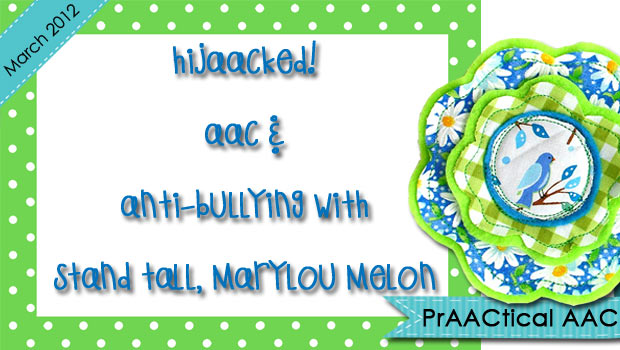
Stand Tall, Mary Lou Melon by Patty Lovell is a fun book that we like reading online* with kids who use AAC. Many schools have anti-bullying campaigns and read this book and others as part of their efforts to help children recognize and respond appropriately to unkind words and deeds. There are a lot of great resources for reading this book on sites like this one intended for use in general education classrooms. We decided it was time to HijAACk Mary Lou and share some ideas for using this wonderful story to build AAC and language skills. – 1. Beginning communicators could certainly contribute to the ‘read aloud’ portion of the activity with repeated lines, like “So she did.” Recording that into a single message device, an SGD, or an AAC app gives our student a terrific way to be actively engaged. 2. Students who can discriminate between two options can... [Read More...]









